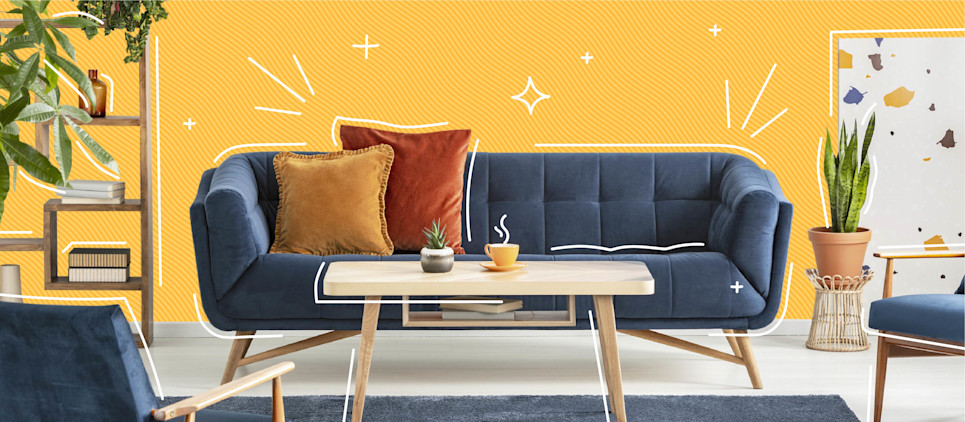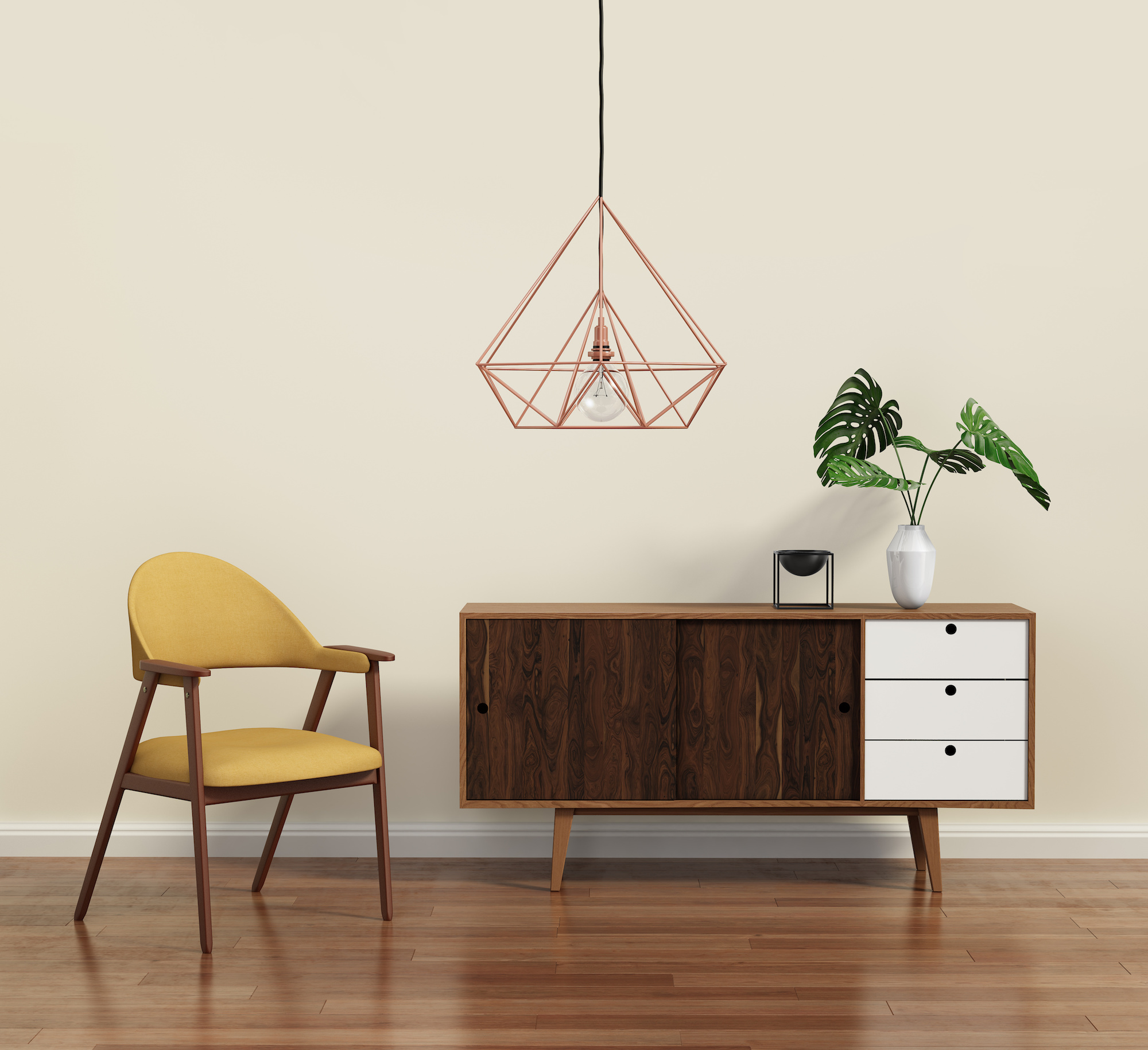Everything You Need to Know About Mid-century Modern Design
Though its very name implies retro vibes, mid-century modern style is still, well, modern—it’s everywhere, from art museums to the shelves of West Elm. The term “mid-century modern” was coined by author Cara Greenberg in her 1984 book, Midcentury Modern: Furniture of the 1950s. The style of design was later catapulted to the forefront of pop culture by the TV show Mad Men.
Why has the style endured in popularity more than half a century later? Perhaps there’s something about the clean-lined pieces, organic shapes, and pops of color that feels simple in an increasingly complex, technology-driven world.

Table of contents
4 Characteristics of mid-century modern designHistory of mid-century modern design5 Ways to make your home a mid-century modern masterpiece4 Characteristics of mid-century modern design
Simplicity: Perhaps the most obvious feature of mid-century modern furniture is its minimalism. You won’t find ornate details, floral carvings, or shimmery mosaics on mid-century modern furniture. Instead, picture a sleek table with a plexiglass top, a pert couch with tapered wooden legs, or a light fixture made of clean, clear spheres of glass.
Rich colors: Mid-century design often features graphic pops of color. Think jewel tones, comic book brights, and bold black and white.
Interplay between organic and bold: While mid-century design is graphic and simple, it is also, somehow, soft and inviting. An Eames chair mimics the gentle curve of a human body, yet presents itself as a perfectly symmetrical abstraction. Corners tend to be rounded, while cushions hold a firm shape. Patterns are simple and repetitive versus whimsical or textured.
Form and function work together: No mid-century living rooms or pieces of furniture are for display only; one defining feature of the aesthetic is an inviting, unpretentious utilitarianism. An Eames chair is not only a statement piece, but is also famously comfortable.
History of mid-century modern design
Mid-century design saw its heyday between the 1930s and the 1960s, and came about as a result of the various changes in economic systems internationally during the time period.
World War II and the Cold War that followed it pushed the United States to build an economy of mass production As the United States moved from large-scale production in the World War II years to the post-war boom in the 1950s, the economy began to shift from being simply industrialized to focusing on mass production and services. The designs of the time period reflect the utilitarian mindset necessitated by the war and the need for mass-produced goods.
This time period also saw the rise of office employment, in which more Americans went to work in office buildings than ever before. Mid-century furniture designers contributed to office design at scale. Iconic furniture company Herman Miller is credited with inventing the cubicle, and the company’s ergonomic office chairs and adjustable desks are still considered some of the best on the market.
Finally, World War II and the post-war era saw more contact among Americans and Europeans as many Europeans left their home countries in search of more stability in the states. A few legendary European architects and designers and their fresh sensibilities left a mark on mid-century America and beyond:
Richard Neutra immigrated to the United States from Austria in the 1920s and defined the modern look of Los Angeles by designing a plethora of homes characterized by large windows, sleek exteriors featuring bold shapes and mixed materials, and a use of pattern or repetition versus ornamentation. Many of the homes Neutra designed are now designated as historical landmarks.
Copenhagen-born designer and architect Arne Jacobsen is known for his iconic Drop, Egg, and Swan chairs, which are still commonly found in many homes and offices. Inspired by the classic Eames furniture designs, the Egg Chair is at once comforting and otherworldly, resembling a seat out of the control center of a spaceship; the Swan chair is like the Egg’s younger sister—smaller, and less imposing.
Eero Saarinen, a Finnish-American architect and industrial designer who immigrated to the U.S. with his parents when he was a teenager, went on to design the now-classic tulip chair and table. Both pieces feature a single bell-shaped leg that makes a mod statement despite its simplicity. Saarinen, in true mid-century modern tradition, also designed many major corporate headquarters and airports, and was inspired primarily by architects such as Mies van der Rohe.

5 Ways to make your home a mid-century modern masterpiece
Today, authentic mid-century modern pieces are priced to reflect their historical significance. But the aesthetic has proliferated to the point that replicas and mid-century-inspired pieces can be found in most mass-market furniture stores at every price point.
But embracing mid-century modern design isn’t just about buying pieces to decorate your apartment; it’s also about embracing the ethos of marrying form and function and valuing simplicity and approachability. Here’s how to be your own mid-century modern interior designer.
1. Give everything a home
The major defining characteristic of mid-century modern design is minimalism. It’s hard to attain the sleek, streamlined look of a mid-century modern masterpiece if your desk is covered with empty Pringles cans and your dining room table is being used as a coat rack. Think about hiding clutter in drawers, chic boxes, closets, or under-bed storage containers. You can also get creative with peg boards for storing office supplies and kitchen gadgets. Keeping your surfaces clean and clear will help you attain the minimalist effect.
2. Choose a color palette
Color is an integral part of mid-century modern design. Since many pieces with this aesthetic include pops of color, it can be helpful to settle on a color scheme ahead of time to avoid clashing.
Analogous color schemes, or color schemes formed by choosing three to five colors that are all next to each other on a color wheel (e.g., red, yellow, and orange, or blue, green, and purple) can work well with mid-century modern design to keep things looking sleek rather than cartoonishly colorful. Don’t forget to choose some black, white, and otherwise neutral pieces to draw your eye to the colorful pieces.
3. Look for classic mid-century modern elements in every piece you purchase
While there’s an art to determining if a piece is authentic mid-century modern (that is, from the actual time period), determining if something has been created in the style of mid-century modern is much easier. Look for tapered legs, wood, lucite, leather, and tweed.
If a piece has ornate decoration like hand-painted florals, carvings, lumpy cushions, rattan, gold painting, or looks like it could have once been placed on a farm, it’s not mid-century modern—it’s another style (possibly hygge or Art Deco) and likely will look out of place with a low, oval coffee table or imitation Eames chair.
4. Bring the outside in
Plants are a great way to achieve a mid-century modern look since the shape of the leaves tends to mimic the classic furniture’s organic shape. Fiddle leaf fig trees, monsteras, and rubber trees are all good bets. The bigger the better—plants offer an excellent opportunity to vary the height of the pieces in your apartment.
5. Play with scale
On that note, try playing with scale across the board. If you have a low coffee table, maybe an arc lamp would create a dramatic effect. Pair an oversized leather pillow with a small, round one on a couch. Or try tall candlesticks with a striking paperweight.
Although mid-century modern design was born more than 50 years ago, it still reigns supreme among universally appealing design trends due to its approachability and versatility. While there is a determined set of characteristics that make up the mid-century modern look, it’s also universal enough that you can put your own spin on it. So don’t be afraid to take that tapered-legged table and make it your own.
Bungalow is the best way to live with roommates. Our homes are designed for shared living, located in the best neighborhoods, and take care of the details—like furnishing common spaces with mid-century-inspired decor, scheduling monthly cleanings, and handling payments. Whether you already have roommates or are looking for new ones, there’s a Bungalow with your name on it. Find your Bungalow.
Ready to find your next home?
Move-in ready homes and a built-in community so you can feel at home, together — wherever you are.
Suggested articles



